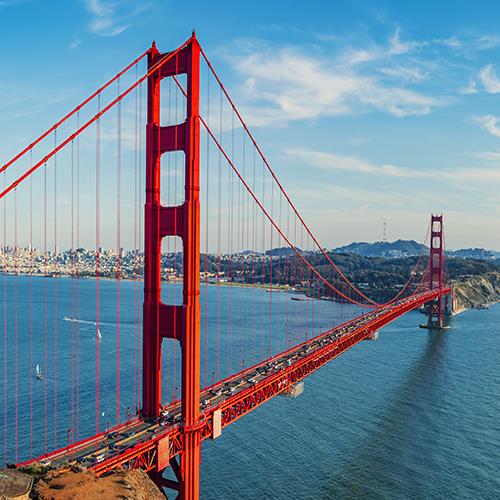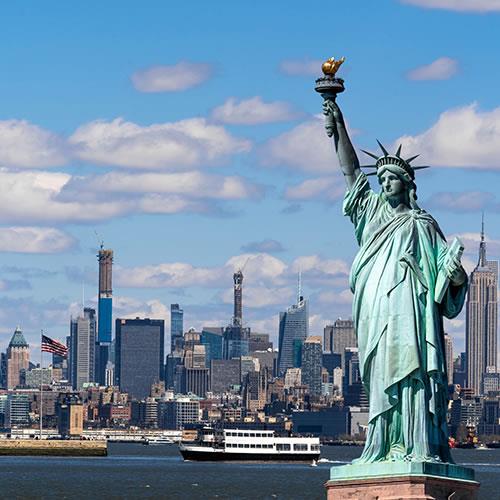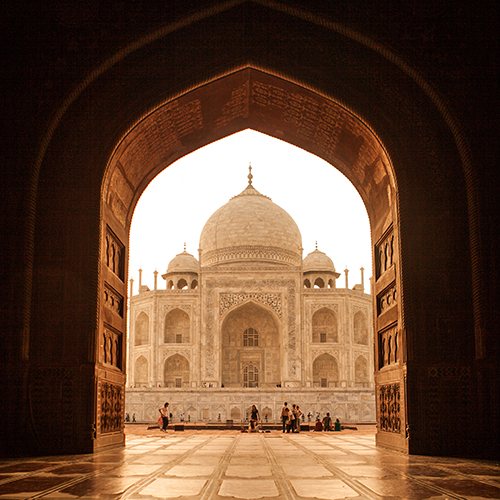Man can make such beautiful, useful, and dynamic things with his hands. That was true thousands of years ago when ancient civilizations were building impossibly large structures and monuments, and that timeless sheer force and might has accelerated at lightning speed with the advent of modern industry and technology. We’ll let you know about 12 marvels of engineering in-depth, how you can visit these destinations with the help of Tripmasters, and we’ll give you some more inspiration in four curated galleries if the marvels we selected didn’t whet your appetite for a monumental vacation!

Serious proposals seeking to link England and France via a tunnel underneath the English Channel have been written and proposed for two centuries, but it wasn’t until 1988 when work began on the 31-mile railway tunnel that connects the cities of Dover and Folkestone in Kent, England, with the city of Calais in the northern French region of Hauts-de-France. The tunnel was the largest undersea construction ever undertaken, taking 15,000 workers six years to complete at a total cost of £9 billion (£16.5 billion in 2021 terms, or $22.6 billion). You can book a seat on a Eurostar train (top speed: 186 mph!) that takes you from London St Pancras Station through the Channel Tunnel to such destinations as Brussels, Rotterdam, Amsterdam, Paris, Lyon, Avignon, and Marseille. You can also choose to drive your rental car to the Folkestone Terminal (pictured) in Cheriton, Kent, where you will ride on the Eurotunnel Shuttle, taking you to the Calais Terminal in Coquelles, near Calais.
The Hoover Dam (pictured) was built for two major reasons. One was for irrigation purposes, and the other was to provide hydroelectric power for much of the Southwest. Thousands of workers spent five years building the dam, from 1931 to 1936, at a cost of over $700 million in 2021 dollars. Las Vegas, Nevada, a small town in the 1930s, boomed due to the influx of workers from back east looking for a job in the middle of the Great Depression, altering the city’s demographics permanently in the process. Damming the Colorado River at the Nevada/Arizona border, 30 miles from Las Vegas, created Lake Mead, the largest reservoir in the United States. For decades, the Hoover Dam provided the majority of power services for the states of Arizona, Nevada, and California, and is still an active power station today. One of the most majestic examples of American strength and ingenuity, the Hoover Dam is a popular tourist attraction, with over a million visitors each year taking the tour inside the dam walls.


Palm Jumeirah (pictured) was the first of many land reclamation-turned-property developments built off the coast of Dubai, United Arab Emirates, in the waters of the Persian Gulf. The Ruler of Dubai, the late Sheikh Maktoum bin Rashid Al Maktoum, came up with the idea of reclaiming the islands from the sea using no steel reinforcements, just rocks and sand, which was unique when construction began in 2001. The islands were reclaimed, infrastructure was built, and homes and buildings were constructed in a six-year process that cost $12 billion ($16 billion in 2021). Developed by Dubai-based Nakheel, Palm Jumeirah is connected to the mainland by car and by monorail and is developed in the shape of a tree, with homes on the “branches” and hotels, resorts, restaurants, theme parks, and nightclubs on the “trunk” and outer islands. Nearly fifteen years after Palm Jumeirah’s first residents moved in, the population has exploded to over 80,000, and Palm Jumeirah is now a popular residential and commercial area in Dubai.



(The Netherlands)
The Millau Viaduct (pictured) in the Occitanie region of France is one of the world’s highest bridges, stretching on for over a mile and a half over the Tarn River at a peak height of 1,104 feet above the ground. The viaduct takes people on the A75 autoroute from Paris to either Béziers or Montpellier. Construction started on the viaduct in 2001, led by Michel Virlogeux (who designed the Vasco da Gama Bridge in Lisbon) and Norman Foster (who led the renovation on Berlin‘s Reichstag). After three years, the bridge was completed at a cost of €394 million ($615 million in 2021 dollars). The Millau Viaduct holds records in the following categories: highest pylons in the world (803 feet high), highest bridge tower in the world, and highest road bridge in Europe (your car, at its highest point, will be 890 feet over the Tarn Valley below). For comparison purposes, the Millau Viaduct is hundreds of feet higher than other bridges featured in this blog. Heralded as one of the engineering marvels of modern times, the International Association for Bridge and Structural Engineering gave the design team the 2006 Outstanding Structure Award.


By the late 19th century, traders got tired of having to go around Cape Horn at the southernmost point of South America to transport cargo between the Atlantic and Pacific Oceans. There was an idea to dig a canal 47 miles through Panama from Colón on the Atlantic side to Panama City on the Pacific side, which the French began in 1881 and abandoned after 13 years. In 1904, the U.S. restarted construction and finished it 10 years later, at a cost of $375 million, the most expensive engineering project undertaken by the U.S. at that time ($10.2 billion in 2021 value). After an upgrade which lasted from 2007-2016, boats pass through five locks. The first two, Gatun Locks (pictured) and Agua Clara Locks, transfer boats to and through Gatun Lake. After sailing past the city of Gamboa in the Culebra Cut, boats meet three more locks as they arrive in the vicinity of Panama City: the Pedro Miguel Locks, the Miraflores Locks, and the Cocoli Locks. One of the seven wonders of the modern world according to the American Society of Civil Engineers, the Panama Canal made it easier for goods and people to travel between the world’s two largest oceans.
The Akashi Kaikyo Bridge (pictured) is the world’s longest suspension bridge, connecting the mainland of Japan‘s largest island, Honshu, to Awaji Island in the Inland Sea. Directly linking the cities of Kobe and Iwaya in Hyogo Prefecture, the bridge clocks in at a length of 2.43 miles; the central span is the longest of any bridge in the world (1.23 miles). The Akashi Strait is infamous for its unfavorable weather conditions, which sank a number of ferries in the mid-20th century. As the ferry was the only way for people to reach Awaji Island from Honshu, the government decided to act and build a road connection across the strait. Plans were officially drafted in 1973 to build a bridge, but it wasn’t until 1988 when construction began. The bridge is built not only to withstand gale-force winds and other inclement weather conditions, it is also designed to withstand earthquakes. The 1995 earthquake in Kobe, which devastated the city, left the bridge (which was still being constructed at the time) unscathed. It was finished on time, in April 1998, at a cost of ¥500 billion ($6 billion in 2021).





The original suspension bridge engineering marvel was of course the Golden Gate Bridge, which crosses San Francisco Bay and links San Francisco with Marin County, California. U.S. Route 101 and the Pacific Coast Highway utilize this bridge; before construction was completed in 1937, San Francisco Bay was only passable via ferry. The construction was not just impressive for being the tallest and highest suspension bridge built at that time, but also for the fact that it was finished very quickly, in just four years, at a cost of $35 million ($560 million in 2021). Plans were developed by San Francisco city leaders to build a bridge as early as 1916, but it took two decades to build this iconic bridge that is a marvel of engineering and also one of the most photographed and visited tourist spots in the United States.
Engineers don’t always create and build based on whether their creations will be seen by the general public. The Large Hadron Collider (pictured) was built from 1998 to 2008 by the European Organization for Nuclear Research (CERN) and is stored in a tunnel more than 500 feet below the surface of the France/Switzerland border, west of Geneva where CERN is based. The Large Hadron Collider is the world’s largest and highest-energy particle collider. What does that mean exactly? Colliders are important when it comes to the study of particle physics because they can help answer questions like what the relation is between quantum mechanics and general relativity, how firm are basic laws of physics between particles when they are forced to interact, and the meaning of time and space. The Large Hadron Collider also helps scientists and engineers study the nature of dark matter, and if there are more dimensions in the universe that humans can detect. While you won’t be able to visit the Large Hadron Collider, you will be able to take tours of CERN in Geneva, where you can see their work with the Collider first-hand.


Burj Khalifa, like many of the cutting-edge developments that dot Dubai‘s skyline and coastline, was the brainchild of the former Ruler of Dubai, Sheikh Mohammed bin Rashid Al Maktoum, who wanted to “put Dubai on the map with something really sensational“. Sensational it is (pictured at left), towering over the rest of Dubai’s glittering cityscape at a height of 2,722 feet — over a half-mile high! Construction occurred between 2004-2009, at a very high cost of $1.5 billion ($1.88 billion in 2021). Sheikh Khalifa bin Zayed Al Nahyan, the Ruler of Abu Dhabi, paid for costs exceeding the original budget, and Dubai named the building after him as a tribute. Burj Khalifa is meant to be the centerpiece of a larger residential and commercial area, which includes such landmarks as the Dubai Fountain and Burj Khalifa Lake, The Address Downtown residential skyscraper, and The Dubai Mall. When it opened to the public in January 2010, Burj Khalifa boasted 163 floors, 57 elevators, and over 3.3 million square feet of commercial and residential space. It is the tallest building and structure in the world, and has been since its completion.



The Bailong Elevator (pictured) clocks in at 1070 feet and is the highest outdoor elevator in the world, designed by the German Rangger Elevator Company at a cost of 180 million yuan ($43 million in 2021). It’s located in Wulingyuan, a UNESCO World Heritage Site in Zhangjiajie, Hunan Province, China. Wulingyuan is a beautiful area consisting of forests and gorges surrounding large quartzite sandstone pillars, of which there are over 3,000 in the protected area. It is one of the largest elevators in the world, capable of transporting 4,000 passengers per hour at a rather high rate of speed considering its size. The trip up to the top of the pillar takes less than 90 seconds! Once at the top, you can view the beautiful scenery around and below you. Did you know that the “Hallelujah Mountains” in Pandora, the world in James Cameron’s film Avatar, was modeled after the pillars in Zhangjiajie? All the more reason to take a vacation to this beautiful section of China.


The Three Gorges Dam (pictured), which spans the Yangtze River at Yichang in Hubei Province, China, is the world’s largest hydroelectric project and the world’s largest power station. The power generated daily by this dam (22,500 megawatts at any one time) can power over five million households for a month. A dam spanning the Yangtze isn’t a new concept, having first been proposed in 1919, but it wasn’t until smaller dams along the Yangtze were completed when the Chinese government finally decided to act on its older proposals. Construction began in 1994 and was completed in 2003, using nearly seven times the amount of concrete needed to construct the Hoover Dam, and enough steel to build 63 Eiffel Towers. The massive undertaking cost 203 billion yuan ($47.3 billion in 2021), but with its lucrative large-scale electricity generation, the cost for the dam was completely recouped by 2013. Want to see the Three Gorges Dam? Book a Tripmasters vacation that takes you on a Yangtze River Cruise.
The Grand Canyon in Arizona is one of the most beautiful natural wonders of the United States, and now it is home to a marvel of engineering as well. David Jin, with the agreement of the Hualapai Nation, worked with architect Mark Ross Johnson to construct a cantilevered U-shaped bridge which juts out 70 feet from the top of a cliff at Eagle Point. The bridge, made of reinforced glass so you can see directly below, is suspended about 800 feet above the ground, and about 3,000 feet above the Colorado River (the lowest point of the canyon). 120 people are allowed on the bridge at any given time, even though the bridge can withstand the weight of seven times as many people. The Grand Canyon Skywalk (pictured) was opened to the public on March 28, 2007, and cost Jin and the Hualapai Nation $30 million to construct ($39.6 million in 2021), but with over 370,000 visitors annually who pay $20 plus tax to walk on the Skywalk, the cost to the nation ended up being a good investment and ultimately a boon to the local indigenous population.


(Moscow to Vladivostok, Russia)


(Skagway, Alaska to Whitehorse, Yukon, Canada)
Which of these marvels of engineering did you like the most? No matter which one you preferred or how far away it is from you, you owe it to yourself to see all of them in person. Head over to Tripmasters.com and you can look at our exciting vacation destinations in over 120 countries and territories throughout the world. For more inspiration, check out our other blog, 12 Architectural Legends and the Structures That Made Them Famous.
